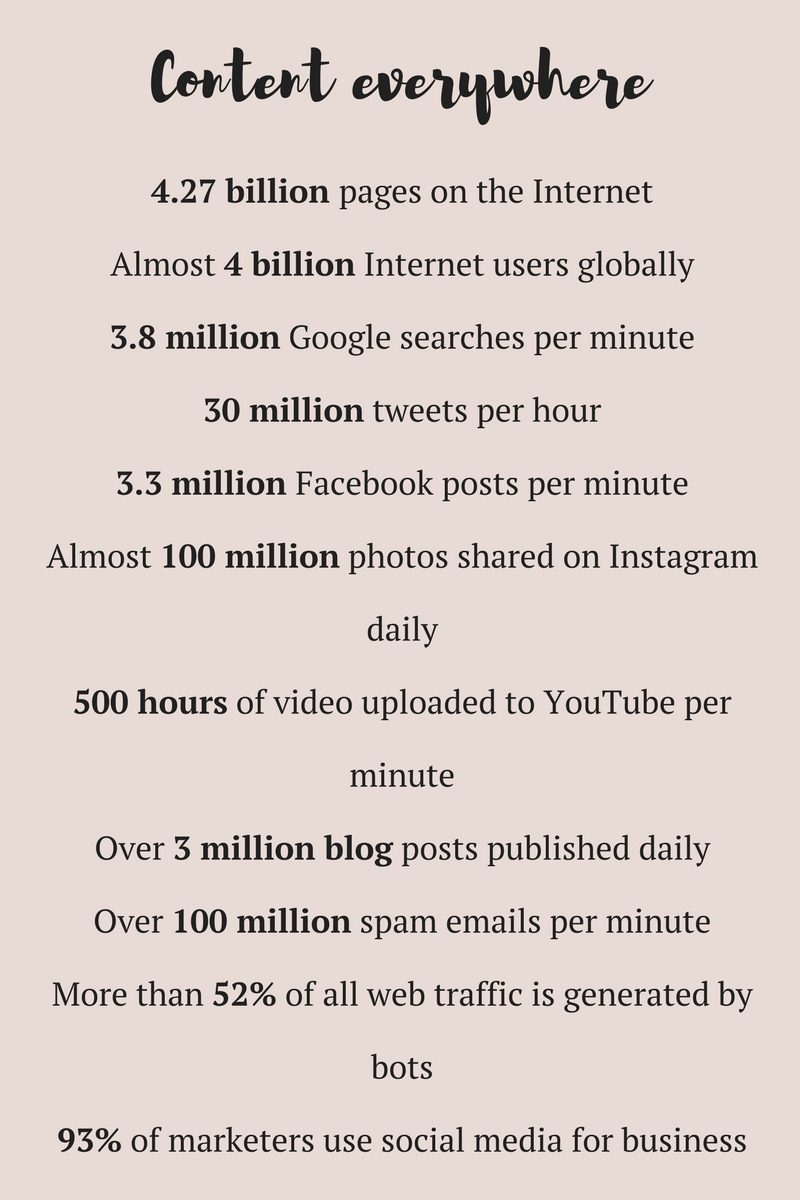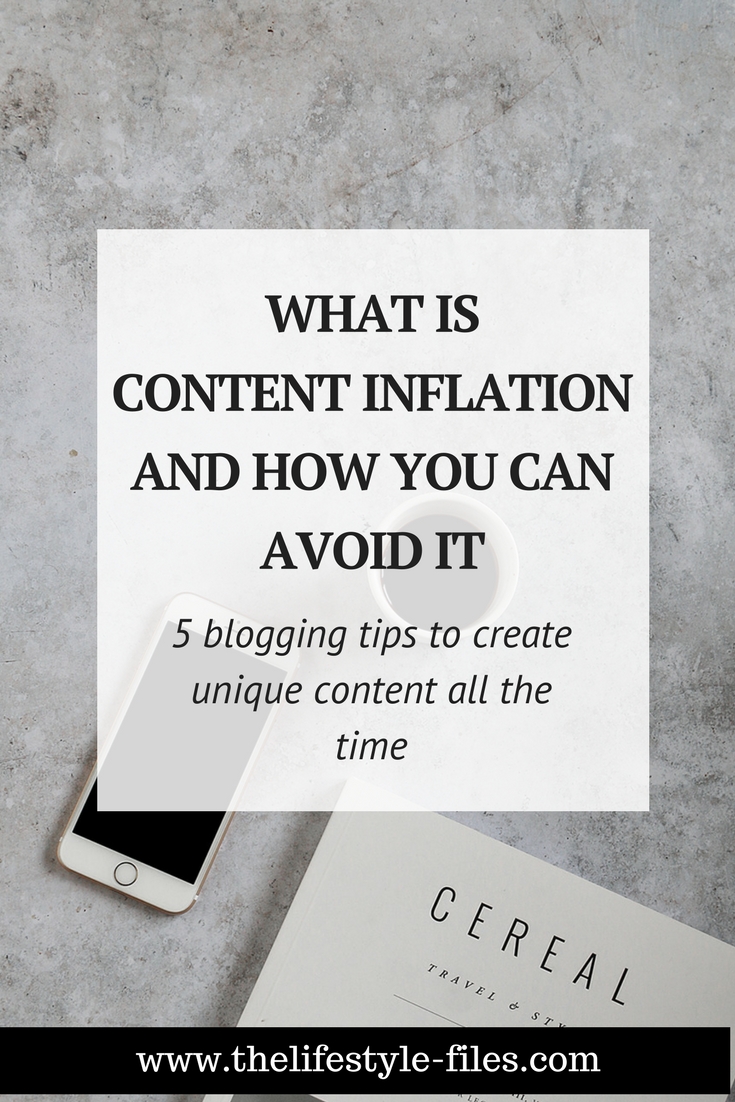
Just gonna let that sink in for a moment.
(Data from WorldWideWebsize.com, Smart Insights, IFL Science, DMR, The Atlantic)
Content inflation – too much, too often
Content inflation simply means that there is more content going around the Internet than ever, but its worth and value is quickly decreasing.
There IS still good and valuable content out there – but it’s quite difficult sometimes to find that among the spam emails, Buzzfeed quizzes, Internet trolls, totally average 12 tips on how to be happy self-help articles, dozen social media platforms, doubling-by-the-second Disqus threads, myriad online magazines, news channels, YouTube channels, blogs, vlogs, social hyperactivity, and the overwhelming amount of ads.
When you have to make a lot of decisions in a given time, you’ll eventually develop decision fatigue. We are flooded with so much content weekly, daily, and hourly, that I guess most of us struggle with some level of content fatigue.
I know that sometimes it gets so overwhelming that I just shut down everything – essentially closing myself off from truly valuable content as well.
So, the most critical issue we face today:
+ How do we cut through this noise?
+ How can we ensure we remain visible in this massive content sea and don’t get buried by a myriad other content?
+ How can we be certain that our content is still valuable and we haven’t fallen into the trap of content inflation?
How to avoid content inflation

Quality over quantity and the Pride Test
Cliché? Yes.
True nevertheless? Absolutely.
Quality over quantity is still one of my most essential slow blogging principles. And the longer I blog, the more convinced I am of the usefulness of this principle.
In the last couple of months, I had a lot less free time to dedicate to blogging so I cut back on the amount of time I post from 3 to 2 or sometimes even 1 per week. Not gonna lie, I was nervous a little how this would affect my audience and traffic or whether I’d lose my readers’ attention if I’m not constantly before their eyes.
I didn’t.
Actually, my traffic has been growing a lot lately, despite the decreased frequency of posting. For me, this was just a personal proof that’s it’s OK if we don’t give in to pressure and churn out content just for the sake of it.
How do I decide whether to post something or not? It’s a very simple pride test. Even if the post is not totally perfect or may have some small issues, if I can honestly say that I’m proud of my work and I can’t wait for people to read it – it goes online. I did scratch several posts in the past because they didn’t pass that test. No matter how much I have worked on them; I’d rather go a full week without posting than publish something I have uneasy feelings about.
I honestly think that most of us would rather wait for some unique and engaging content than being presented average quality every day of the week.
It’s OK to not post. It’s OK to sit that one trend out. It’s OK to listen, instead of constantly talk.
Get to know your readers and build a community
If you’re talking to everyone, you’re essentially talking to no one.
I think one of the main culprits of content inflation is ignorance about the needs and preferences of our audience. There’s a reason why most marketing and branding experts suggest starting with a customer or audience profile. We must know whom we are talking to in order to create good content. If we would like to please every single person with an Internet connection, that will lead nowhere.
Try to imagine your ideal reader. Try to assess what would be valuable to them. Analyze your data – but do not be deceived by vanity metrics, like simple follower counts. Go deeper and try to establish a real connection.
We’ve collectively arrived at this state of content inflation because we are simply swamped by content. And it’s often one-way content, meaning the emphasis is on producing more and more and not on getting feedback and creating an engaged community. Sure, it’s important to find new readers and customers. But it’s even more important to keep the existing ones, who have already at least once graciously given us their attention.
Be strategic about your channels
Can you tell me just one influencer whose content you actively consume and engage with (not just follow) on at least 5 different channels (blog, YouTube, Facebook, Twitter, Instagram, Pinterest, Snapchat etc)? Someone who creates unique, interesting, and different content for all channels?
I honestly can’t.
Because smart content creators know the importance of prioritizing.
There’s absolutely no need to be all over the place – there is such a thing as overexposure. Especially, as all the different platforms require different skills: from photography through curating to writing or videography. We all have different strengths and the smart thing is to focus on those. There are three things to consider when selecting your strategic channels:
- What are you good at?
- What type of content do you enjoy creating?
- Where is your audience and where does your traffic mainly come from? (check the audience part of Google Analytics)
Don’t get blogging FOMO and be strategic about your social media focus – pick 1 or 2 as the top priority and spend most of your energy there.
Surprise your audience (and yourself)
Good blogging is a careful balancing between predictability (in terms of writing style, quality, knowledge, expertise) and variety. While it’s important to establish credibility and authority when it comes to different topics, I think it’s also worth stepping out of the confines of your niche or expertise and surprise yourself and the audience as well. It doesn’t mean you have to be all over the place with your topics, but it’s fine to experiment.
Don’t get too comfortable, try different issues, angles, types of contents, editing etc. This is how we push ourselves further and further and can get out of the comfort zone.
Pay attention to trends, but dare to be a trendsetter
Social media and blogging trends come and go, but it can be important to pay attention to them. A trend always signifies some kind of collective social interest, therefore it’s bound to be popular and bring about attention – at least with the right timing.
It’s smart to keep up with the major current of the giant Internet flow, but only until we’re either ahead or on top of it.
Remember the ALS ice bucket challenge that swept through the digital world in 2014?
It was a great cause and great marketing initiative that got picked up immediately. Celebrities and influencers were fast to catch on and produced more and more creative videos. Then everyone was doing it, the novelty wore off, and the videos became repetitive. The cause was equally good, the idea equally fun, but it’s been overdone to the point of content inflation.
The same thing is happening all the time with blog post ideas, IG story templates and quizzes, hashtags, trending cafés, flatlay backgrounds, challenges, and titles. I think it’s important to pay attention to these trends, but not at all costs. Just because everyone does it, it doesn’t mean I have to do it as well. When it comes to emerging trends, I always ask myself: does it make sense for me to join? Can I add anything unique or a personal twist?
Participate if you’d like, but dare to start your own trends as well.
They gotta start somewhere, after all.






